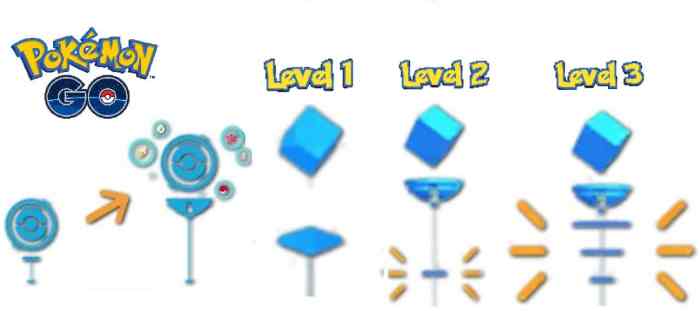Pokestops in Pokemon GO are ubiquitous in-game landmarks that serve as hubs for item collection, gameplay strategy, and community interaction. These interactive locations offer a diverse range of benefits and rewards, making them essential destinations for players of all levels.
From their widespread distribution patterns to their unique visual appearances, Pokestops play a significant role in shaping the gameplay experience. They foster social interactions, promote local business involvement, and contribute to the overall inclusivity and accessibility of the game.
Pokestop Definition and Overview

Pokestops are ubiquitous landmarks in the augmented reality game Pokémon GO. These virtual hotspots provide players with essential in-game items and serve as social gathering points for the community.
In-game, Pokestops appear as blue cubes with a glowing beacon on top. Interacting with a Pokestop grants players various items, including Poké Balls, Potions, Revives, and Eggs. Pokestops also serve as locations where players can spin Photo Discs to collect items and earn experience points.
Pokestop Distribution and Locations

Pokestops are strategically placed in real-world locations, often at points of interest or community hubs. Common Pokestop locations include:
- Historical landmarks
- Public parks
- Businesses and shops
- Libraries and schools
- Community centers
Factors influencing Pokestop placement include historical significance, cultural relevance, and accessibility for players.
Types of Pokestops

There are various types of Pokestops, each with its unique visual appearance and in-game significance:
- Standard Pokestops:Blue cubes with a glowing beacon, providing standard items.
- Sponsored Pokestops:Blue cubes with the logo of a sponsoring business, offering additional rewards.
- Gyms:Larger, yellow structures where players can train and battle Pokémon.
- Photo Discs:Rotating discs at Pokestops that grant items and experience when spun.
Each type of Pokestop offers different rewards and gameplay opportunities.
Pokestop Mechanics and Gameplay
Interacting with a Pokestop involves spinning the Photo Disc to receive items. Pokestops have a cooldown period before they can be interacted with again, typically 5 minutes.
Pokestops play a crucial role in gameplay:
- Item collection:Pokestops provide essential items for catching, healing, and evolving Pokémon.
- Leveling up:Spinning Photo Discs earns experience points, contributing to player level progression.
- Strategic gameplay:Pokestops serve as strategic points for capturing and defending Gyms.
Pokestop Community and Social Aspects

Pokestops have fostered social interactions and community building among Pokémon GO players:
- Gathering points:Pokestops attract players, creating opportunities for socialization and collaboration.
- Community events:Pokestops serve as focal points for community events, such as raids and meet-ups.
- Local business impact:Sponsored Pokestops and increased foot traffic around Pokestops have benefited local businesses.
Pokestop Accessibility and Inclusivity
Efforts have been made to improve Pokestop accessibility for players with disabilities:
- Wheelchair accessibility:Many Pokestops are located in wheelchair-accessible areas.
- Audio cues:Pokestops emit audio cues to assist visually impaired players.
- Community outreach:Niantic collaborates with organizations to ensure equitable Pokestop distribution.
Detailed FAQs: Pokestops In Pokemon Go
What are Pokestops in Pokemon GO?
Pokestops are interactive landmarks in Pokemon GO that provide players with items, experience points, and other rewards.
How do I find Pokestops?
Pokestops are typically located near real-world landmarks, such as historical sites, public art, and businesses.
What are the different types of Pokestops?
There are several types of Pokestops, including regular Pokestops, sponsored Pokestops, Gyms, and Photo Discs.
How often do Pokestops respawn?
Pokestops typically respawn every 5 minutes.
Can I request a Pokestop to be added to the game?
Yes, you can submit a request to Niantic, the developer of Pokemon GO, to add a Pokestop to the game.
